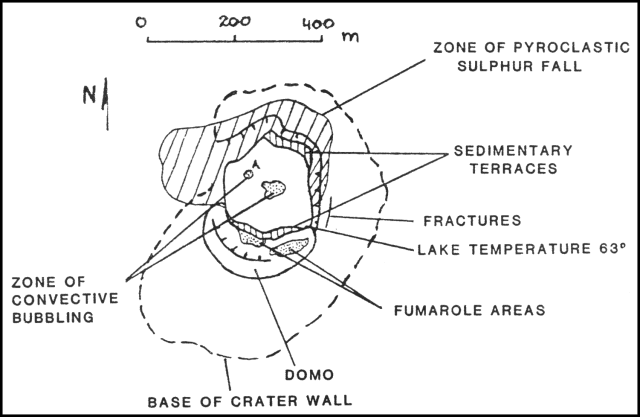Report on Poas (Costa Rica) — April 1988
Scientific Event Alert Network Bulletin, vol. 13, no. 4 (April 1988)
Managing Editor: Lindsay McClelland.
Poas (Costa Rica) Strong phreatic explosions deposit acidic mud and sulfur
Please cite this report as:
Global Volcanism Program, 1988. Report on Poas (Costa Rica) (McClelland, L., ed.). Scientific Event Alert Network Bulletin, 13:4. Smithsonian Institution. https://doi.org/10.5479/si.GVP.SEAN198804-345040
Poas
Costa Rica
10.2°N, 84.233°W; summit elev. 2697 m
All times are local (unless otherwise noted)
Activity in the hot crater lake has been increasing since phreatic eruptions resumed in June 1987. In August 1987, eruptions occurred about every 45-60 minutes. By January 1988 activity was characterized by series of 2-3 individual eruptions, separated from each other by approximately 1 minute and from other eruption series by five or more minutes.
Park guards reported that residents of Poásito, 5 km SE of the crater, described a fall of "ash" on 9 April at about 0300 that stained plastic and plant leaves. Another large explosion at 0725 emitted a vapor plume estimated at 2 km height and dropped acidic sulfur-rich mud on visitors, cars, and plants at the tourist overlook. Observations on 13 April showed that plants were stained with mud and some were burned; leaves on some plants were completely burned, particularly the new shoots. Impacts of the very moist mud droplets were submillimeter-sized with a mean density of 14/cm2 (for the two eruptions). Around the hot lake there was a spray of pale yellow sulfur pyroclastics, kidney-shaped or like grease spots, with mean diameters of 0.5-1 mm and maximum lengths of 2 cm. The shapes of the pyroclastics indicated that the sulfur was molten when ejected. This material reached 10 m E of the E edge of the lake, some 50 m onto the N meseta, and carpeted the NW and W walls to about 150 m height (figure 2), suggesting a directed blast toward the W. A quick and preliminary analysis of seismograms from Poás station did not show a notable increase in seismicity, nor events that could be clearly associated with the phreatic explosions.
The temperature of the lake was 65°C and its pH was 0.45 on 11 April. A fumarole on the remnant of the 1953-5 [dome] had a temperature of 298°C on its upper part, while 587°C was registered W of it. Park guards reported continuous and persistent headaches without irritation of mucous membranes (eyes, mouth, respiratory system), effects commonly experienced at the edge of the lake. These effects correspond to those of CO, CO2, and H2S (Faivre-Pierret and Le Guern, 1983) but the gas discharge from the fumaroles and its concentration in the air have not been measured.
In late April, mud eruptions occurred an average of once every 3 minutes. The lake color had changed slightly to yellowish green from dark green in January. The N-S-trending fractures in the E wall of the lake had generated small rockfalls that came to rest on the terrace sediments. The temperature of the SE edge of the lake, beside the remnant of the 1953-5 [dome] (figure 2) was 63°C, similar to that of January. In the NW part of the lake (point A on figure 2) convective bubbling occurred every 15-60 seconds. Some of the bubbling episodes brought sediment to the surface, coloring the water gray, as well as a yellowish sulfurous scum. Mud plumes were ejected from point A and the center of the lake an average of about once every 3 minutes, generally to estimated heights of 5-10 m, with the highest to 60-100 m.
Reference. Faivre-Pierret, R., and Le Guern, F., 1983, Health risks linked with inhalation of volcanic gases and aerosols, in Tazieff, H., and Sabroux, J.C., eds., Forecasting Volcanic Events: Elsevier, Amsterdam, p. 69-81.
Geological Summary. The broad vegetated edifice of Poás, one of the most active volcanoes of Costa Rica, contains three craters along a N-S line. The frequently visited multi-hued summit crater lakes of the basaltic-to-dacitic volcano are easily accessible by vehicle from the nearby capital city of San José. A N-S-trending fissure cutting the complex stratovolcano extends to the lower N flank, where it has produced the Congo stratovolcano and several lake-filled maars. The southernmost of the two summit crater lakes, Botos, last erupted about 7,500 years ago. The more prominent geothermally heated northern lake, Laguna Caliente, is one of the world's most acidic natural lakes, with a pH of near zero. It has been the site of frequent phreatic and phreatomagmatic eruptions since an eruption was reported in 1828. Eruptions often include geyser-like ejections of crater-lake water.
Information Contacts: G. Soto, Univ de Costa Rica (UCR); Guillermo Alvarado, ICE; J. Barquero and E. Fernández, OVSICORI.


